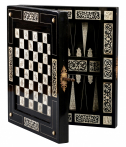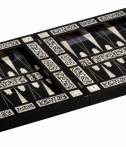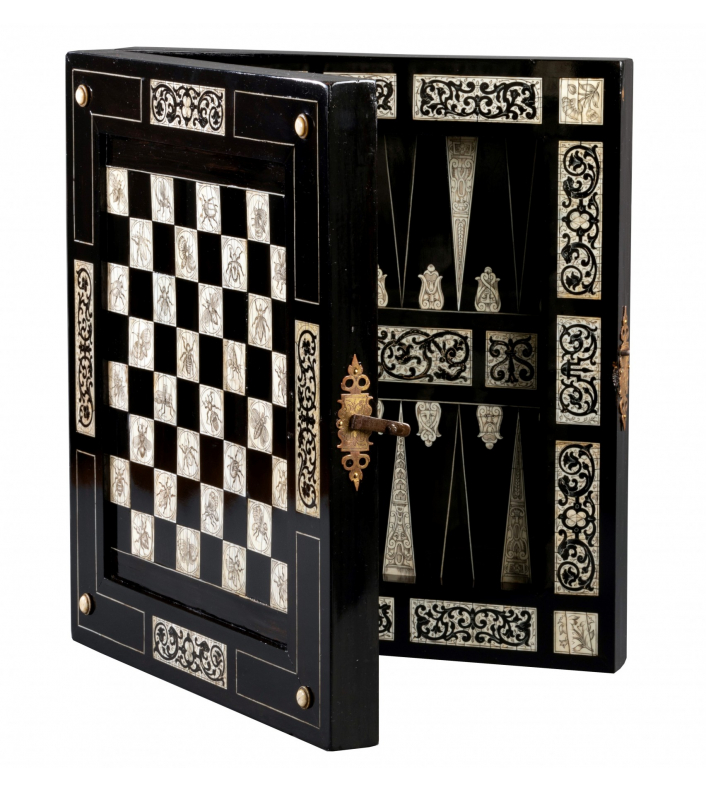This extraordinary games board we are offering is a rare example of an exceptional level of skill achieved by Augsburg cabinetmakers. It is also a reflection of German princely court's lifestyle famous for their extraordinary luxury and refinement associated with the development of the Kunstkammers (cabinets of curiosity)
Playing games, an occupation worthy of princes, rises the interest for games boards and makes them essential for cabinets of curiosities.
Rectangular in shape, our box allows to play checkers, chess, Nine men’s morris, and once opened the backgammon. Closed it could contain pawns and accessories inside.
Made with engraved ebony and ivory marquetry, its rich and precious decor is the result of a collaboration between a cabinetmaker and an engraver on ivory and ebony.
The lid features on one side the diamond shaped Nine men’s morris game, decorated in the center with an ivory medallion depicting the two backgammon players.
The four triangles framing the game are decorated with marquetry enriched with monkeys placed in the middle of the scrolls, these monkeys are strongly inspired by playing cards engraved by Virgil Solis (Nuremberg, 1514-1562).
The back of the box is occupied by a chessboard.
The chessboard is decorated with ivory squares minutely engraved with insects which were undoubtedly inspired by the engravings of Joris Hoefnagel taken from his work Archetypa Studiaque Patris published in 1592. The work of J. Hoefnagel constitutes an important stage in the 'observation of flora and fauna in a realistic and diligent approach. The book has inspired many painters of still life in the 17th century.
The care and meticulous aspect of the engraving, the shadows created by hatching, the details of the legs and wings of insects, allow to appreciate the talent and the commitment of the artist-engraver, transforming an object of entertainment into an object with strong didactic power.
Our games board perfectly reflects the spirit of the German princely courts, luxury and leisure went hand in hand with scientific research and contemplation of the universe. A prince had to be learned, educated, but also sensitive to the world around him. The chess game helped to enhance one of the most important qualities of a ruler, the ability to be a fine strategist.
The interior of our box reveals a game of backgammon designed by alternating twelve pyramidal sections in ivory engraved with grotesque ornaments and the mascarons separating them from ebony sections. The central part as well as the borders are decorated with ivory and ebony marquetry engraved with leafy scrolls concealing stylized heads of animals and dogs chasing hares. These scenes inside backgammon hint that the game can turn into a hunt.
The ivory squares engraved on the corners illustrate different varieties of flowers, indicating an interest in botany.
Our games box belongs to a group of similar games boards attributed to Ulrich Baumgartner and his workshop, the most famous cabinetmaker from Augsburg in the 17th century.
The origin of our box is thoroughly attested, thanks to the the stamp of the city of Augsburg and the guild of master cabinetmakers guaranteeing ebony (the pine cone for the city of Augsburg, and EBEN for ebony).
This stamp became mandatory in 1625, we can date the creation of our box around this time.
Augsburg, circa 1630, workshop of Ulrich Baumgartner.
Excellent condition.
Dimensions: h. 7,5 cm, w. closed 38,5 cm, open 77 cm, d. 44 cm
Ulrich Baumgartner (1580-1652)
Ulrich Baumgartner was specialized in the manufacture of cabinets, boxes, games boards and other objects for Kunstkammers.
He became famous after creating the cabinet called the Pommerische Kunstschrank ordered by a major art dealer Philippe Hainhofer (1578-1647) intended for Duke Philippe of Pomerania. Baumgartner delivered the cabinet in 1617 with multiple accessories, the most famous of which was the integrated chess board.
This ebony and engraved ivory chessboard is held today at the Museum of Decorative Arts in Berlin, the cabinet to which it belonged has been destroyed.
Similar games boards
The engraved decoration of our chessboard s by its decoration of insects to the play box of the Philadelphia Museum of Art.
This same decor of insects is used on a chessboard from the Christie’s sale, however it is engraved ebony. Amsterdam, 20/11/2012, lot no 70.
These two objects also come from Ulrich Baumgartner's workshop
In museums:
Games box, GRASSI Museum of Applied Arts, Leipzig
On the art market:
Games box, Georges Laue collection, Munich
The games boards
Board games were very much appreciated in the 17th century. It is the favorite pastime of the rich and the poor, men and women from all over Europe.
The games boards used for this entertainment have a representative role in high society. The need to surround oneself with everyday luxury items in order to assert its status pushes the rich and powerful to acquire games boards made with precious and exotic materials such as ivory, amber, silver or rare woods. Ivory is also called "white gold" during this period. As for ebony wood, imported by Venice, so expensive, that a document of this time informs us that its use is intended only for princes and nobles.
Kunstkammer (cabinet of curiosities)
Kunstkammer defines itself as a personal space dedicated to the conservation and exhibition of multiple collections created to reflect the world, in other words a forerunnes of current museums.
The German princely courts of the early 17th century guided by curiosity and the desire to discover and learn about the world bring together incredible collections of objects classified into several categories: Naturalia (minerals, animals, plants), Artificialia (works of art), Scientifica (scientific instruments).
The EBEN stamp
Following a conflict in 1588 between the woodturners and cabinetmakers guild and over which guild should be responsible for working the ebony, the decision was made in favor of the cabinetmakers. During the following decades, however, ebony was so successful that some dishonest craftsmen used ebonized pearwood, masquerading as ebony and so deceiving their customers.
The guild, responsible for controlling its members work’s quality, retaliated in 1625 by introducing the mandatory inspection by the grand masters of the guild of all ebony goods and the authentication of the wood validated by a stamp with the word "EBEN" next to the "pinecone" for Augsburg.





